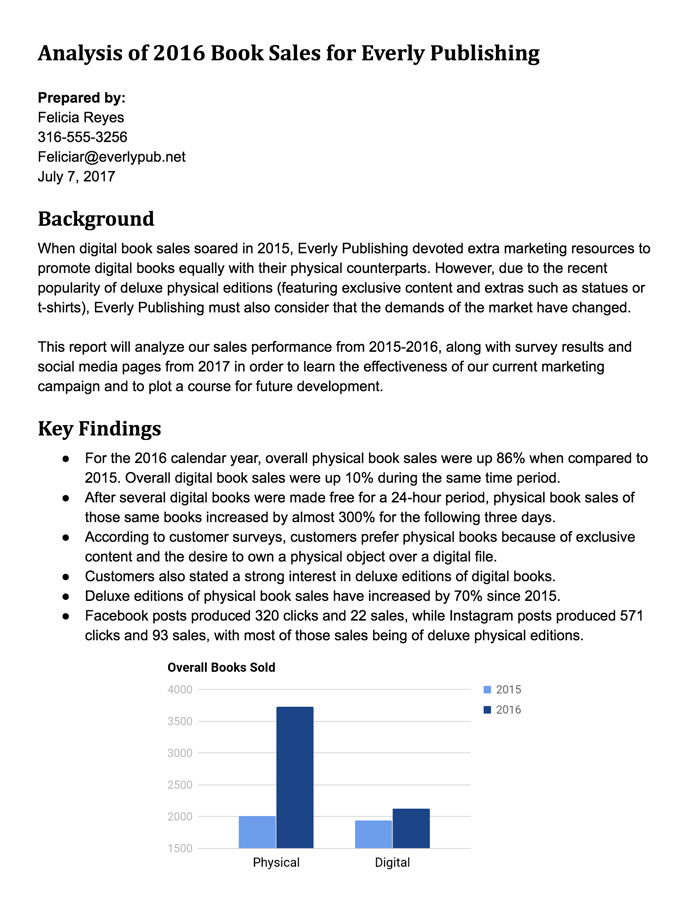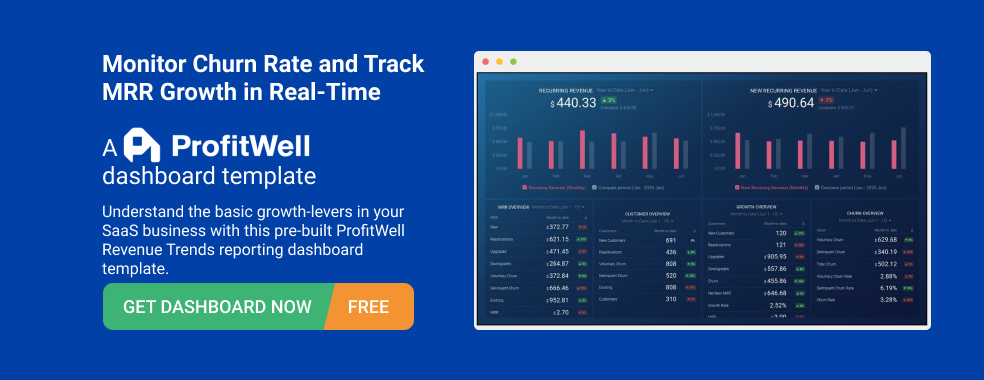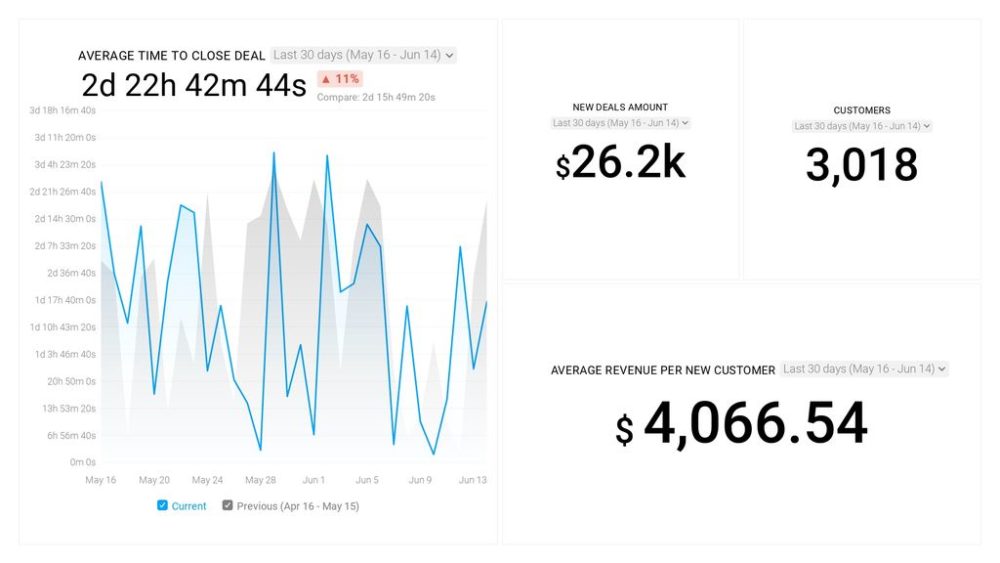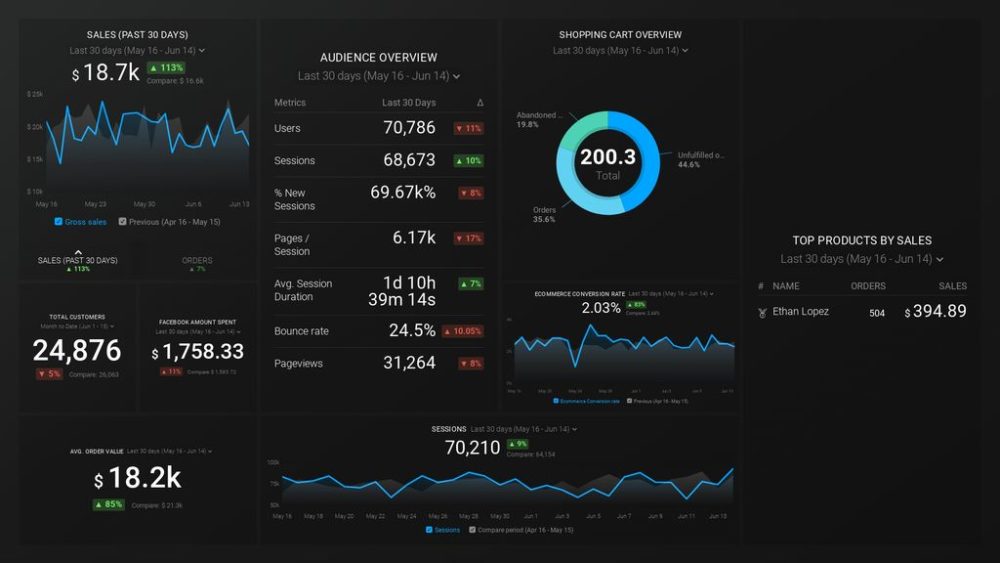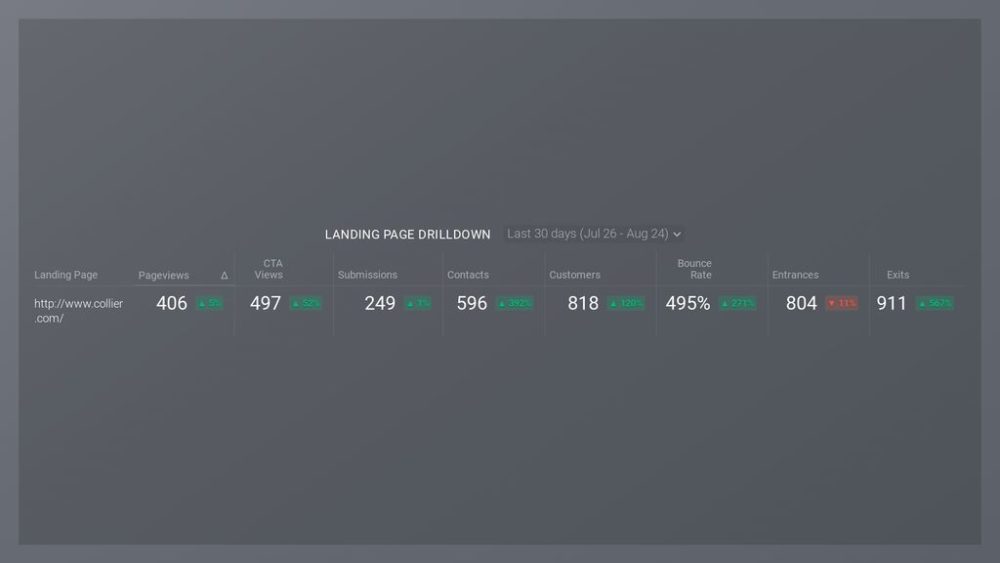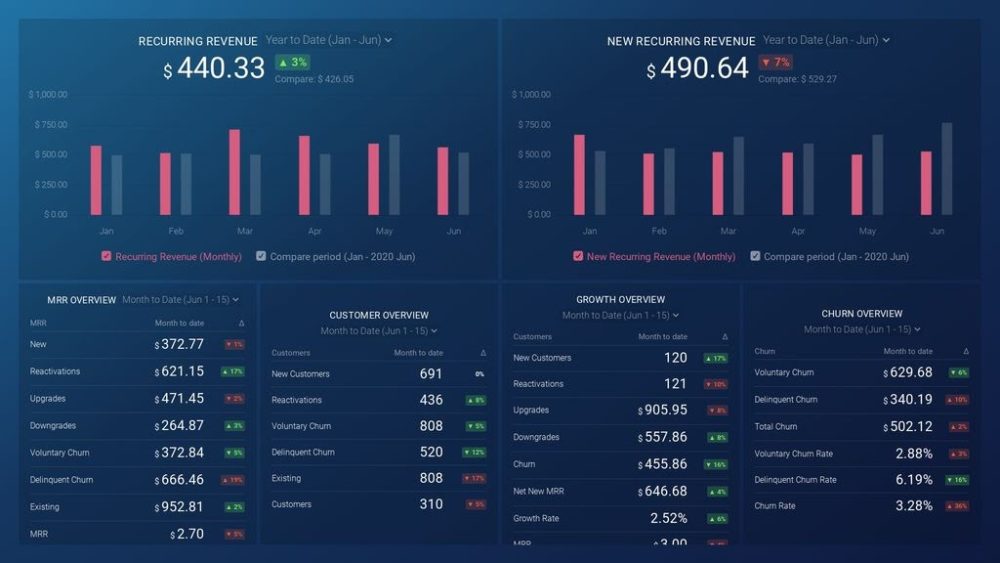How to write a business report
How to write a business report
How to write a business report
Revolut Contributor
Writing effective business reports is critical to the success of any ambitious business. The key however is to capture your audience and ensure it is easy to follow. This will keep the readers attention throughout the report.
A business report is a written document that provides information and analysis to assist a particular business project or strategy. The main purpose of a business report is to support the management of a business with a decision making process. The report needs to make this data easy for the reader to understand. The best way to do that is to have clearly defined sections with labels and headings.
We have set out below the key aspects of a successful business report:
Title Page
Given the nature of the report you are writing you must start with an eye catching title page which details exactly what the report is about and who is the author. This immediately grabs the readers attention and gives them a clear overview of what is expected in the report.
Executive Summary
This page is often considered one of the most important pages in the document. The executive summary is designed to give the readers of the report a snapshot overview of the key points from the report. The executive summary will also detail the key findings in the report and any recommendations or conclusions the report has discovered. In certain reports this is the main source of information for the reader who may be short of time or prefer to read an overview/summary rather than the whole report. It therefore must be clear, precise but also provide all the relevant information from the report itself.
Introduction
A successful business report will also have a strong and informative introduction of the basis that has been provided for the writing of this report. The reader will be looking to understand the fundamental points raised prior to writing the report and what the report aims to set out.
Methodology and Findings
The main body of the report will contain two main sections. The first of these being the methodology and subsequent findings from the report. This section will set out the basis of the research and why the particular research method was chosen.
Once this has been set out, the report can highlight the key findings which have arisen from the report. A key tip here though is not to provide too much written data which is hard to follow. Try using graphs and tables to grab the reader’s attention!
Conclusions and Recommendations
Once you have set out the methodology and the findings you will then need to detail the conclusions and recommendations you have determined from the report and the basis for these recommendations. The reader will want a short but precise explanation here.
References/Appendix
The final section of a successful business report will include details of all your reference points which support your findings in your report and credit the original creator of that information. You may also wish to include appendixes which can include financial tables and charts to illustrate your findings or conclusions.
Joe David, Founder & CEO, Nephos Accountants
Read next:
About the author
At Nephos we believe that there’s a better way to grow your business. It’s time to bring your accounting into the digital realm, giving you greater control and clarity. The word ‘nephos’ is Greek for cloud, and nephologists study clouds to understand weather patterns. Like nephologists, we focus on the data held within the cloud, looking for patterns and movements that allow us to make the right financial forecasts and predictions. Nephos was built on the principle that technology can, and should, work harder for your business. Compliance is just one side of the coin – we don’t just help our clients to make sure they’re following the rules, we use our knowledge and insights to ensure they’re building for the future.
How to Write a Business Report for English Learners
If you would like to learn how to write a business report in English follow these tips and use the example report as a template on which to base your own business report. First of all, business reports provide important information for management that is timely and factual. English learners writing business reports need to make sure that the language is precise and concise. The writing style used for business reports should present information without strong opinions, but rather as direct and accurately as possible. Linking language should be used to connect ideas and sections of the business report. This example business report presents the four essentials that every business report should include:
Terms of reference refer to the terms on which the business report is written.
The procedure describes the method that was used to collect data for the report.
The findings describe the data or other important information the report produced.
Conclusions are drawn on the findings which provide reasons for recommendations.
The recommendations are specific suggestions made based on the conclusions of the report.
Read the short example business report and follow the tips below. Teachers can print these examples for use in class in lessons using sound teaching writing strategies.
Reports: Example Report
Terms of Reference
Margaret Anderson, Director of Personnel has requested this report on employee benefits satisfaction. The report was to be submitted to her by 28 June.
Procedure
A representative selection of 15% of all employees were interviewed in the period between April 1st and April 15th concerning:
Findings
Conclusions
Recommendations
Important Points to Remember
Continue learning about other types of business documents using these resources:
Business memos are written to an entire office. When writing business memos make sure to clearly mark for whom the memo is intended, the reason for writing the memo and who is writing the memo. Memos tend to inform colleagues of office and procedural changes that apply to a large group of people. They often provide instructions using the imperative voice. Here is an example memo with follow-up important points to use when writing business memos in English.
Example Memo
To: Northwest Area Sales Staff
RE: New Monthly Reporting System
We’d like to quickly go over some of the changes in the new monthly sales reporting system that we discussed at Monday’s special meeting. First of all, we’d once again like to stress that this new system will save you a lot of time when reporting future sales. We understand that you have concerns about the amount of time that will be initially required for inputting your client data. Despite this initial effort, we are confident that you will all soon enjoy the benefits of this new system.
Here is a look at the procedure you will need to follow to complete your area’s client list:
As you can see, once you have entered the appropriate client information, processing orders will require NO paperwork on your part.
Thank you all for your help in putting this new system into place.
Important Points to Remember
Reports
Memos
Email
Introduction to Writing Business Plans
To learn how to write a business email, remember the following: Business emails are generally less formal than business letters. Business emails written to colleagues are generally direct and ask for specific actions to be taken. It’s important to keep your business emails short, as the easier it is to reply to an email the more likely it is that a business contact will reply quickly.
Example 1: Formal
The first example shows how to write a formal business email. Note the less formal «Hello» in the salutation combined with a more formal style in the actual email.
I read on your website that you offer Music CD copying for large quantities of CDs. I’d like to inquire about the procedures involved in these services. Are the files transferred online, or are the titles sent by CD to you by standard mail? How long does it usually take to produce approximately 500 copies? Are there any discounts on such a large quantity?
Thank you for taking the time to answer my questions. I look forward to your response.
Example 2: Informal
The second example shows how to write an informal email. Notice the more conversational tone throughout the email. It’s as if the writer were speaking on the phone.
At 16.22 01/07 +0000, you wrote:
> I hear you’re working on the Smith account. If you need any information don’t hesitate to get in > contact with me.
Listen, we’ve been working on the Smith account and I was wondering if you could give me a hand? I need some inside information on recent developments over there. Do you think you could pass on any information you might have?
Example 3: Very Informal
In the third example, you can see a very informal email which is very similar to texting. Use this type of email only with colleagues with whom you have a close working relationship.
At 11.22 01/12 +0000, you wrote:
> I’d like a suggestion for a consulting firm.
How about Smith and Sons?
Important Points to Remember
Reports
Memos
Email
Introduction to Writing Business Plans
How to Write a Powerful Business Report
Business Communication: How to Write a Powerful Business Report
Lesson 8: How to Write a Powerful Business Report
How to write a powerful business report
When a company needs to make an informed decision, it can create a business report to guide its leaders. Business reports use facts and research to study data, analyze performance, and provide recommendations on a company’s future.
Watch the video below to learn how to write and format a business report.
The basics of a business report
Business reports are always formal, objective, and heavily researched. Every fact must be clear and verifiable, regardless of whether the report focuses on a single situation or examines the overall performance of an entire company.
Because objectivity is crucial in a business report, avoid subjective descriptions that tell the reader how to feel. For instance, if sales were down last quarter, don’t say “Sales were terrible last quarter,” but rather let the sales data speak for itself. There should also be no personal pronouns, such as “I think we should invest more capital.” A business report should remain impersonal and framed from the company’s perspective.
The structure of a business report
Although the size of a report can range from one page to 100, structure is always important because it allows readers to navigate the document easily. While this structure can vary due to report length or company standards, we’ve listed a common, reliable structure below:
Some companies may also require an executive summary after the front matter section, which is a complete summary that includes the report’s background, key findings, and recommendations. This section lets people learn the highlights quickly without having to read the entire document. The size of an executive summary can range from a paragraph to multiple pages, depending on the length of the report.
Revision
As mentioned in Business Writing Essentials, revision is key to producing an effective document. Review your writing to keep it focused and free of proofreading errors, and ensure your factual information is correct and presented objectively. We also recommend you get feedback from a colleague before submitting your work because they can spot errors you missed or find new opportunities for analysis or discussion.
Once you’ve revised your content, think about the report’s appearance. Consider turning your front matter section into a cover page to add some visual polish. You can also create a table of contents if the report is lengthy. If you’re printing it out, use quality paper and a folder or binder to hold the report together. To diversify the presentation of your data, try using bulleted lists, graphics, and charts.
Example of a business report
To demonstrate the principles of this lesson, we’ve created a brief business report for you to review.
Let’s start by looking at the first page of this two-page report.
The layout of the front matter is simple and effective, while the background sets the stage in a quick, specific manner. The key findings provide the main takeaways that warrant further investigation, along with a chart to add emphasis and visual variety.
Now let’s look at the following page.
The conclusion features a little of the writer’s opinion on the key findings, although the writing is still centered around the company’s perspective. The recommendations are clear and supported by the data, while the references are thorough.
While business reports may seem intimidating, you have the ability to create a thorough, informative document through practice and careful research. Collect the facts and present them in an organized, objective manner, and you’ll help your business make informed decisions.
How To Write a Formal Business Report in 11 Steps
By Indeed Editorial Team
Updated May 24, 2022 | Published February 25, 2020
Updated May 24, 2022
Published February 25, 2020
Copy to Clipboard
Formal business reports have important functions in helping managers and executives make decisions. These documents can have a variety of purposes depending on your needs and industry. Learning how to write a formal business report can help you develop as a professional.
In this article, we explain what a formal business report is, how to write one and provide an example.
What is a formal business report?
A formal business is an official document that contains data, research, information and other necessary details to help decision-makers form plans and objectives to help the company. Depending on the topic, a formal business report could be several pages long and include extensive data and information. Here are a few of the most common types of formal business reports, designated by a purpose:
Justification/recommendation report
You can use this report to propose an idea to management. The body would include sections like risks, costs and benefits. An example of this type of report would be to propose buying a machine for your workplace. To convince the decision-maker to buy the machine, you would create this report to make a convincing argument.
Investigative report
This report can present the potential risks of a specific opportunity. This report is helpful for business owners to anticipate any issues involved in making an investment or purchase. You could also create a formal business report to analyze a proposed merger.
Compliance report
Use this report when the organization wants to show accountability and create a compliance report. It is a report that allows an organization to prove that it is following regulations and that it is spending money properly. For example, an accountant could write a compliance report to show the company followed federal laws regarding spending.
Feasibility report
When you need to analyze the outcomes of a proposed idea, you can use this report. The report could cover potential problems, associated costs and the benefits of the idea. With this report, you can determine if the proposal will be profitable, if the deadline is feasible and if there’s a chance it could exceed the budget.
Research studies report
This report helps you analyze a problem
. The report would include recommendations to resolve the problems.
Periodic report
This report helps an organization improve its products, services, processes or policies. The report can include things like profit and loss information or it may examine efficiency. For instance, a retail store would have a monthly report on its sales.
Situational report
To discuss a specific topic, such as information from a conference, use a situational report.
Yardstick report
You can use this report to present several solutions as options for a particular situation.
How to write a formal business report
Follow this step-by-step guide to create a professional business report:
1. Plan before you write
Treat the formal business report as you would handle a project. Before you start compiling research and writing down sections, plan exactly what you want to achieve. In doing so, you will have a better chance of creating a report in a clear and simple style.
2. Check for an in-house format
The company you work for may already have an established format for formal business reports. Check your company handbook or ask the person who wants the report to see if there’s a specific format you should use. Using an established format will help your report look more professional.
3. Add a title
You might get the title of the report with the brief or you may write it yourself. Make sure the title is clear and visible at the beginning of the report. You should also add your name and the names of others who have worked on the report and the date you wrote it.
4. Write a table of contents
The table of contents page should follow the title and authors. The table of contents page is essential for a formal report that is long and complex. Although this page comes at the start of the report, it should be written last when the report is finished. Write down the section headings exactly as they appear in each section of the report and make sure the page numbers match too.
5. Add a summary or abstract
The summary summarizes the main points of a formal business report. It can be beneficial for the reader to have this section, but it is not mandatory, especially if your report is short. It is best to ask the person who has requested the business report if they prefer a summary or abstract. Although the summary comes at the beginning of the report, you should write it last, along with the contents page, so that you can include notes from your conclusion and recommendations section.
The summary should tell the reader about your findings and even draw on points from your conclusion. A brief overview of what the reader will find in the report is also important. Your manager may only have time to read the summary of the report, so it must describe the major points found in the report.
6. Write an introduction
This section will detail the reason why you are writing the report. The introduction should address the purpose of the report and background information on the subject you are writing about. Include any definitions and summarize the main argument.
7. Outline your methodology
The methodology section should explain to the reader the research methods you have chosen to create this report, such as using a qualitative method, a quantitative method or a combination of both. It should be a clear justification of why you chose to use certain methods.
8. Present your findings
This section is where you should present the outcome of your research. It is important to present your results logically and succinctly while making sure that you have included enough information to prove that you have researched the matter thoroughly.
One way of making the findings easier to read is by using headings, subheadings and numbered sections to organize everything. You can choose to present your findings in bullet points or with the help of a table. You might also choose to present your findings with illustrations and graphics—such as infographics—but be sure that these graphics are appropriate for the report.
9. Finish with a conclusion and recommendations
In this section, you would present your assessment from the findings, then make recommendations for action. If you add any goals, you should add measurable actions to them. Each goal, method or option suggested should tell the reader how it will affect the organization.
10. Add a bibliography and appendices
Include all of the sources you have used to write the report. These can include periodicals, online articles or books. List the sources in alphabetical order. You can also include all of the material to support the report. These may include questionnaires, maps, notes, summaries, charts, tables, illustrations and others. Label each note, map and other documents with a letter so that you can reference them clearly in the report.
11. Proofread
Once you’re finished writing your report, proofread it to make sure it’s free of any grammatical or spelling errors, which will make your report more credible. Moreover, be clear and concise when writing. Avoid complex words and slang. It is acceptable to use jargon and technical terms appropriate to the industry you are in, but avoid overusing them. Make sure that the writing flows from one section to another, especially if there was more than one author on the report.
Formal business report example
Here’s a sample formal business report that you can review as a guide:
Report on Staff Turnover in GHS Corporation
Submitted Aug. 8, 2019
The human resources manager requested this report to examine the high turnover rate of employees at GHS Corporation. The information in this report was gathered by members of the human resources department over three months. The five-member team analyzed administration records and working conditions, as well as interviewed staff. In this report, recommendations are made to minimize the high turnover rate among the staff working at GHS Corporation.
GHS Corporation has been operating for 10 years. It employs 200 people, with most of the employees tasked with processing fees for insurance clients. Despite operating in a region with substantial unemployment, the annual turnover has been between 60 to 65% every year.
The most significant issue found by the HR team when interviewing staff was the lack of support to new mothers who require child care services to be able to come to work. Employees mentioned their frustration at not having an in-house child care system that could help them continue working.
Another issue mentioned by the staff was the lack of communication between employees and upper management. They expressed their concerns about receiving inconsistent and late instructions. They shared how they didn’t know the main business objectives which led them to lose interest in the company and their jobs.
The main issues that we found were as follows:
1. Lack of support to new mothers in regards to childcare
2. Lack of communication between the staff and upper management
To address these two main issues, we recommend the following steps be taken:
1. An in-house childcare center can be established at minimal cost to GHS, encouraging mothers to return to work.
2. Each department should choose an employee ambassador to represent the interests of staff in management meetings. This ambassador can express concerns and relay outcomes to their teams to increase engagement.
Business Report: What is it & How to Write a Great One? (With Examples)

With so much experience under your belt, you already know a lot about business reporting.
So, we don’t want to waste your time pointing out the obvious because we know what you need.
Secrets. Tricks. Best practices.
The answer to how to write a mind-blowing business report that you don’t need to spend hours and days writing.
A business report that will immediately allow you to identify your strengths and weaknesses.
A report that’ll help you learn more about your business and do more accurate forecasting and planning for the future.
We believe we have just that right here.
With this comprehensive guide, you’ll create effective sales, analytical, and informative business reports (and business dashboards) that will help you improve your strategies, achieve your goals, and grow your business.
So, let’s dive in.
What Is a Business Report?
Although there’s a variety of business reports that differ in many aspects, in short, a business report definition would be the following:
A business report is an informative document that contains important data such as facts, analyses, research findings, and statistics about a business with the goal to make this information accessible to people within a company.
Their main purpose is to facilitate the decision-making process related to the future of the business, as well as to maintain effective communication between people who create the reports and those they report to.
A good business report is concise and well-organized, looks professional, and displays the relevant data you can act on. The point is to reflect upon what you’ve achieved so far (typically, over the past month, quarter or year) and to use the data to create a new strategy or adjust the current one to reach even more business goals.
Business reports should be objective and based on the data. When stating the facts, people rely on numbers rather than giving descriptions. For instance, instead of saying “our conversion rate skyrocketed”, you would display the exact percentages that back up that claim.
Importance of Creating Business Reports
Business reporting matters for several reasons, among which the most important ones are:
Recognizing Opportunities to Grow
If you never look back at what you’ve achieved, you can’t figure out what you’ve done well and what you can leverage in the future for even better results.
When you analyze a specific aspect of your business over a specific time period and present the data you gathered in a report, you can detect an opportunity to grow more easily because you have all the information in one place and organized neatly.
Is it time to introduce new products or services? Is there a way to enhance your marketing strategy? Prepare a report. Can you optimize your finances? Write a financial business report. Whatever decision you need to make, it’s easier when you base it on a report.
Detecting Issues and Solving Them Quickly
Reports are essential for crisis management because they can introduce a sense of calmness into your team. Putting everything on paper makes it easier to encompass all the relevant information and when you know all the facts, you can make a more accurate and effective decision about what to do next.
Writing business reports regularly will also help you identify potential issues or risks and act timely to prevent damage and stop it from escalating. That’s why monthly reporting is better than doing it only once a year.
Having an insight into your finances, operations and other business aspects more regularly allows you to have better control over them and mitigate potential risks more effectively.
Evaluating a Potential Partner
Different types of business reports may be accessible to the general public. And if they’re not, specific situations may require a company to send them over to the person requesting them. That may happen if you’re considering a partnership with another company. Before making the final decision, you should learn about their financial health as every partnership poses a certain risk for your finances and/or reputation. Will this decision be profitable?
Having an insight into a company’s business report helps you establish vital business relationships. And it goes the other way around – any potential partner can request that you pull a business report for them to see, so writing business reports can help you prove you’re a suitable business partner.
Having a Paper Trail
In business, and especially in large companies, it’s easy to misplace information when it’s communicated verbally. Having a written report about any aspect of your business doesn’t only prevent you from losing important data, but it also helps you keep records so you can return to them at any given moment and use them in the future.
That’s why it’s always good to have a paper trail of anything important you want to share with colleagues, managers, clients, or investors. Nowadays, of course, it doesn’t have to literally be a paper trail, since we keep the data in electronic form.
Keeping Things Transparent for the Stakeholders
Writing business reports helps you keep things transparent for the stakeholders, which is the foundation of efficient communication between these two sides.
You typically need to report to different people – sometimes they’re your managers, sometimes they’re a client. But your company’s stakeholders will also require an insight into the performance of your business, and relying on reports will help you maintain favorable business relationships. A business report shows you clearly how your company is performing and there isn’t room for manipulation.
Setting New Company Goals
Once you set business goals and the KPIs that help you track your progress towards them, you should remember they’re not set in stone. From time to time, you’ll need to revisit your goals and critical metrics and determine whether they’re still relevant.
When you write a business report and go through it with your team members or managers, you have a chance to do just that and determine if you’re efficient in reaching your goals. Sometimes, new insights will come up while writing these reports and help you identify new objectives that may have emerged.
Types of Business Reports
Depending on your goals and needs, you’ll be writing different types of business reports. Here are five basic types of business reports.
Informational Report
Informational reports provide you with strictly objective data without getting into the details, such as explaining why something happened or what the result may be – just pure facts.
An example of this type of business report is a statement where you describe a department within your company: the report contains the list of people working in this department, what their titles are, and what they’re responsible for.
Another example related to a company’s website could look like this Google Analytics website traffic engagement report. As we explained above, this report shows objective data without getting too much into the details, so in this case, just the most important website engagement metrics such as average session duration, bounce rate, sessions, sessions by channel, and so on. Overall, you can use this report to monitor your website traffic, see which keywords are most successful, or how many returning users you have, but without further, in-depth analysis.
Analytical Report
Analytical reports help you understand the data you’ve collected and plan for the future based on these insights. You can’t make business decisions based on facts only, so analytical reports are crucial for the decision-making process.
This type of business report is commonly used for sales forecasting. For instance, if you write a report where you identify a drop or an increase in sales, you’ll want to find out why it happened. This HubSpot’s sales analytics report is a good example of what metrics should be included in such a report, like average revenue per new client or average time to close the deal. You can find more web analytics dashboard examples here.
From these business reports, you can find out if you will reach your goals by implementing your current strategy or if you need to make adjustments.
Research Report
Research is critical when you’re about to introduce a change to your business. Whether it’s a new strategy or a new partner, you need an extensive report to have an overview of all important details. These reports usually analyze new target markets and competition, and contain a lot of statistical data.
While not the same, here is an example of an ecommerce dashboard that could help track each part of a campaign in detail, no matter whether you are launching a new product, testing a new strategy, and similar. Similar to a research report, it contains key data on your audience (target market), shows your top-selling products, conversion rate and more. If you are an online store owner who is using paid ads, you can rely on this report to monitor key online sales stats in line with Facebook Ads and Google Analytics. See more ecommerce dashboards here.
Explanatory Report
As you might guess from its name, you write the explanatory report when it’s necessary for you to explain a specific situation or a project you’ve done to your team members. It’s important to write this report in a way that everyone will be able to understand.
Explanatory reports include elements like research results, reasons and goals of the research, facts, methodology, and more. While not exactly an explanatory report, this example of a HubSpot marketing drilldown report is the closest thing to it, as it helps marketers drill into an individual landing page performance, and identify how good their landing pages are at converting, or which ones have the best performance.
Progress Report
A progress report is actually an update for your manager or client – it informs them about where you stand at the moment and how things are going. It’s like a checkpoint on your way towards your goal.
These reports may be the least demanding to write since you don’t need to do comprehensive research before submitting them. You just need to sum up your progress up to the point when the report was requested. This business report may include your current results, the strategy you’re implementing, the obstacles you’ve come across, etc.
In many companies, progress reports are done on a weekly or even daily basis. Here is an example of a daily sales report from Databox. HubSpot users can rely on this sales rep drilldown business report to see how individual each sales rep is performing and measure performance against goals. Browse through all our KPI dashboards here.
What Should Be Included in a Business Report?
What does a great business report look like? If you’re not sure what sections your report should have, you’ll learn what to include in the following lines.
Business Report Formatting
Different types of reports require different lengths and structures, so your business report format may depend on what elements your report needs to have. For example, progress reports are typically pretty simple, while analytical or explanatory reports are a different story.
However, most reports will start with a title and a table of contents, so the person reading the report knows what to expect. Then, add a summary and move on to the introduction. After you’ve written the body and the conclusion, don’t forget to include suggestions based on your findings that will help your team create an actionable plan as you move forward.
After that, list the references you used while creating the report, and attach any additional documents or images that can help the person reading the report understand it better.
This outline may vary depending on what kind of report you’re writing. Short business reports may not need a table of contents, and informative reports won’t contain any analyses. Also, less formal reports don’t need to follow a strict structure in every situation.
Business Report Contents
When it comes to the contents of your report, keep in mind the person who’s going to read it and try to balance between including all the relevant information, but not overwhelming the reader with too many details.
If you decide to include more sections like recommendations, this is where you’ll suggest the next steps your team or the company may want to take to improve the results or take advantage of them if they’re favorable.
PRO TIP: Are You Tracking the Right Metrics for Your SaaS Company?
As a SaaS business leader, there’s no shortage of metrics you could be monitoring, but the real question is, which metrics should you be paying most attention to? To monitor the health of your SaaS business, you want to identify any obstacles to growth and determine which elements of your growth strategy require improvements. To do that, you can track the following key metrics in a convenient dashboard with data from Profitwell:
If you want to track these in ProfitWell, you can do it easily by building a plug-and-play dashboard that takes your customer data from ProfitWell and automatically visualizes the right metrics to allow you to monitor your SaaS revenue performance at a glance.
You can easily set it up in just a few clicks – no coding required.
To set up the dashboard, follow these 3 simple steps:
Step 1: Get the template
Step 2: Connect your Profitwell account with Databox.
Step 3: Watch your dashboard populate in seconds.
:max_bytes(150000):strip_icc()/GettyImages-929070706-5b17fbbc8e1b6e0036c50190.jpg)



